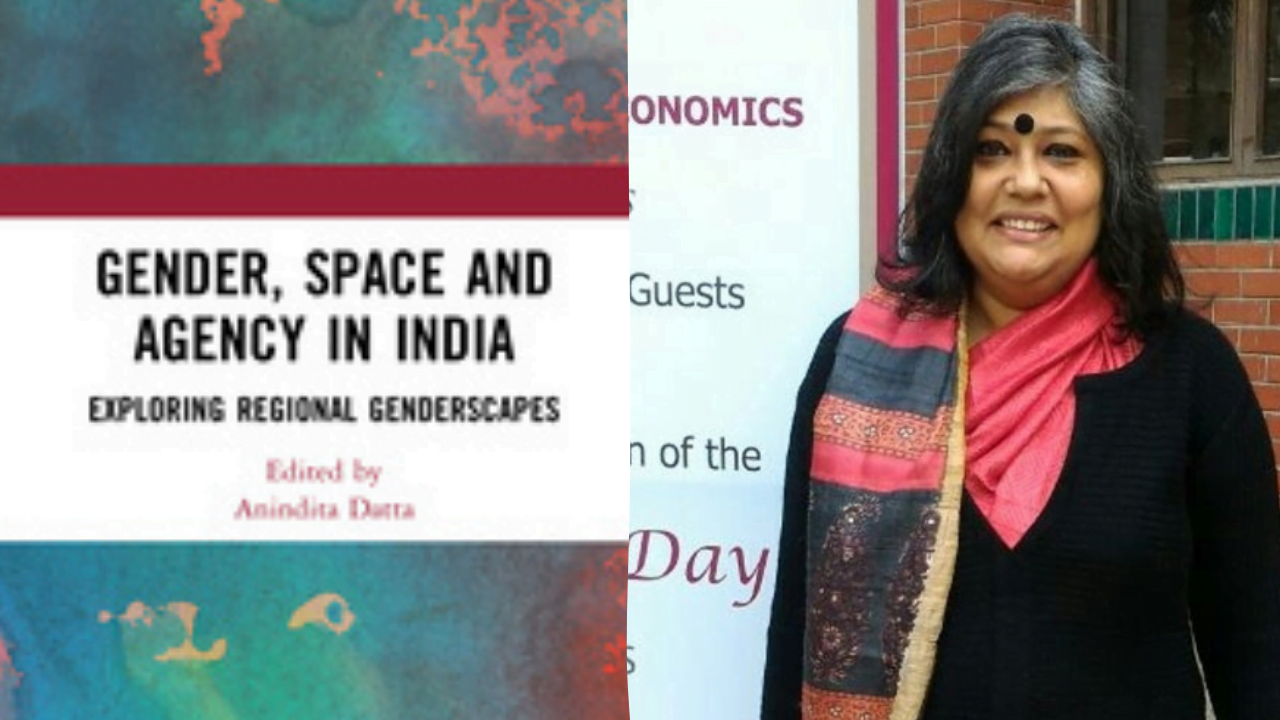Anindita Datta’s edited collection Gender, Space and Agency in India: Exploring Regional Genderscapes aims to illustrate the role of geography in shaping gender relations. Datta begins the first chapter by theorising how spatiality affects the performances of gender in India’s “classic patriarchy,” which Denize Kandiyoti describes as a system where women are subservient to men and other elder women in patrilocal households. The subsequent internalisation of networks of power in classic patriarchy coupled with the ‘doxic’ acceptance of family norms compel women to collude in their own subordination. The totality of the book constitutes a feminist endeavour to examine topographical features that influence women’s epistemic oppression and their access to public spaces.
The totality of the book constitutes a feminist endeavour to examine topographical features that influence women’s epistemic oppression and their access to public spaces.
In the second chapter, Rituparna Bhattacharyya charts out Pierre Bourdieu’s notion of ‘symbolic violence’ in context of Assam to uncover the paradoxical oppositions between lexicons of modernity in postcolonial India. The regional genderscape in Assam has been historically free from dowry. Surrounded geographically by matrilineal subcultures, the state allows women greater freedom than other regions in India. Yet Bhattacharyya reveals that social reform movements and identity politics have still managed to construct classic patriarchy to limit women’s mobility. For instance, one interviewee claims that she wears Mekhela Sadar to gain respect from her husband’s conservative family because “their happiness is my [her] happiness.” This materialises Beate Krais’ notion of symbolic violence as a “subtle” and “invisible” mode of domination that prevents its social recognition.
The next study focusses on the assessment of social spaces and their impact on girls’ education. Each of the four participants has been socialised in a distinct region in India before pursuing graduate education in the US. This enables a comparative account of regional genderscapes and their ability to facilitate or obstruct educational opportunities. Toward the end, Patricia Kewer and Martha Geores cite globalisation as an ‘enabling’ space, which, in their understanding, allows geographical diffusion and aids advancement in education. But a postcolonial reading challenges such academic attempts to credit globalisation with socioeconomic progress considering its role in the sustenance of class divides, particularly in developing countries. Thus, the claim that globalisation and its maintenance of capitalist hegemony can enable social emancipation is contestable.
Gupta argues that unequal property laws script gendered inequality by promoting witchcraft practices that prevent women from exercising their property rights.
Bashabi Gupta’s succeeding chapter presents a fascinating critique of witch-hunting practices that endeavour to curtail women’s property rights in thirteen villages in Jharkhand. Gupta has selected the regions through random sampling to evaluate social relations and ownership patterns in both tribal and non-tribal communities. She argues that unequal property laws script gendered inequality by promoting witchcraft practices that prevent women from exercising their property rights. Such a system exploits women’s vulnerability to enable their sexual and economic subjugation, and sanctions mass hysteria by locating in women’s oppression the solution to male anxieties.
The fifth chapter traces Barnali Biswas’ navigation of women’s access to political spaces in rural West Bengal. The state’s history of decentralisation of political processes gives the impression that local institutions are more democratic, but women’s participation in decision-making continues to lag behind. While the educated and politically conscious women members of the Panchayat in Hugli initiate social interventions to ensure a gender-inclusive public space, women leaders in the less developed district of Puralia find it difficult to translate the advantages of female solidarity into performance, possibly due to their illiteracy. This shows how socioeconomic constraints handicap women’s access to power and their participation in decision-making processes.
As a non-formal space of feminist jurisprudence inspired from establishments like Sabala Sangh, Mahila Panchayats provide a system for redressal to economically marginalised women, which enhance women’s capabilities at the individual level and the group level.
Swagata Basu theorises the “transformatory power” of Mahila Panchayats in low-income neighbourhoods in Delhi. As a non-formal space of feminist jurisprudence inspired from establishments like Sabala Sangh, Mahila Panchayats provide a system for redressal to economically marginalised women, which enhance women’s capabilities at the individual level and the group level. Basu highlights the arbitration process by focussing on two case studies: one concerns a newly-wed wife who was forced to leave her marital household while she was pregnant, while the other deals with the marital dispute between a childless couple after the wife discovers that the husband has fathered a baby boy outside their marriage. The sensitive resolution of these predicaments illustrates the role that Mahila Panchayats play in enhancing the agential capabilities of married women in hostile families, issuing a threat to doxic assumptions in households and other social networks, and enabling their members “to forge solidarities across religion and caste.”
Patriarchal denial of economic agency to widows — who reside within the broader category of single women — in rural Punjab forms the thesis of the next study. The technology-oriented farming system introduced by the Green Revolution eliminated women from farm work. But the period of economic prosperity for farm owners and agricultural labourers also led to a rise in alcoholism and drug abuse among men, which made women the new heads of households. Against this social background, Kanchan Gandhi examines the construction of gender relations in patrilineal systems of inheritance. She cites various factors that reinstate familial and social oppression of widows including, gaps in the law on inheritance, delays in minimalistic pension scheme for widows, proportionality between social inequality and gender-based oppression post Green Revolution, etc.
Also read: Book Review: The Politics Of Reality By Marilyn Frye
The eighth chapter features Ajay Bailey’s exploration of performances of migrant masculinities in Goa. He argues that men from Karnataka migrate to Goa due to rising debts and limited employment opportunities. While they exercise social power in migrant settlements located in the urban periphery, they encounter what M.K. Canales calls “exclusionary othering” by Konkani-speaking Goans who call them “Ghati.” Discrimination thus gets embodied in their performance of masculinity when they interact with the host population. Bailey’s study is followed by Nairwita Bandyopadhyay and Ashis Saha’s work on the influence of topographical factors on gender roles in six select villages in the drought-prone region of Gujarat. They conclude that quotidian domestic practices enable the creation of gender-inclusive or gender-exclusive spaces. Caste composition in villages also dictates power relations, which inhere within their texture the ability to invisibilise gender inequalities.
Sara Smith’s noteworthy evaluation of intimacy and reproduction in political and religious territory-making processes in Leh constitutes the tenth chapter. Kargil, with a Shia Muslim majority, is one of the two districts of the Ladakh region. The other is Leh, which hosts a Buddhist majority. Geopolitical anxiety compels politicians to discourage Buddhist women from using family planning practices, thereby establishing the hegemony between women’s fertility and the state’s pursuit of power. While women’s capacity to give birth to voters renders their bodies in terms of territorial contestations, their participation in pro-natal geopolitical discussions does not discourage them from “falling in love with the wrong person.”
Also read: Book Review: The Orders Were To Rape You By Dr Meena Kandasamy
Datta concludes the final chapter by presenting “a new ontology of agential space” in the concept of feminist counterspaces. To visibilise invisible modes of resistance and resilience, she provides the theoretical frame of indigenous feminisms, which depends on banal acts rooted in the everyday to confront power relationships. Interpersonal strategies that help women maximise their security include masquerade, false compliance, feigned ignorance, resistance through disguised registers, etc. Characteristics of these private acts also get embodied in radical protests that develop feminist resistance praxis: this includes the naked protests of the Meira Paibi in Manipur, the 16-year long hunger strike by Irom Sharmila, Medha Patkar’s call for jal samadhi, and anti-CAA protests led by Muslim women in Shaheen Bagh. These forms of defiance reveal women’s constant resistance through local modes of dissent that suit the spatial contexts where they are located. The essays in the book mark an important intervention in the study of geographies of gender, which makes them important for intersectional feminists.
References
- Datta, Anindita (ed). Gender, Space and Agency in India: Exploring Regional Genderscapes. Routledge, 2021.
- Kandiyoti, Denise. “Bargaining with Patriarchy.” Gender and Society 2, no. 3 (1988): 274–90.
- Bourdieu, Pierre. Outline of a Theory of Practice. Translated by R. Nice. Cambridge University Press, 1977 (1972).
- Krais, Beate. “Gender and Symbolic Violence: Female Oppression in the Light of Pierre Bourdieu’s Theory of Social Practice.” In Bourdieu: Critical Perspectives, edited by Craig Calhoun, Edward LiPuma, and Moishe Postone, 156–77. Polity Press, Blackwell Publishers, 1993.
- Canales, M. K. “Othering: Toward an Understanding of Difference.” Advances in Nursing Science 22, no. 4 (2000): 16–31.
Featured Image Source: Book cover and an image of the editor
About the author(s)
Mridula Sharma is a researcher and a writer. Her work lies in the intersection of feminist theory, postcolonial studies, and popular culture.





